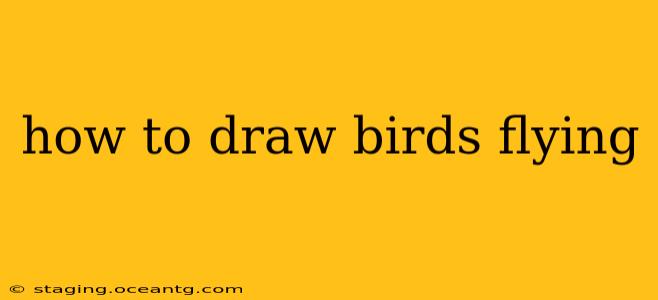How to Draw Birds Flying: A Guide for Beginners and Beyond
Drawing birds in flight can seem daunting, but with the right approach and a little practice, you can capture their dynamic beauty on paper. This guide breaks down the process step-by-step, covering everything from basic shapes to advanced techniques. Whether you're a beginner picking up a pencil for the first time or an experienced artist looking to refine your skills, you'll find valuable tips and insights here.
Understanding Bird Anatomy in Flight
Before diving into the drawing process, it's crucial to understand the basic anatomy of a bird in flight. Observe real birds – watch videos, visit a bird sanctuary, or simply look out your window. Pay attention to:
- Wing Shape and Position: Wings aren't just flat surfaces. They are curved and flexible, constantly adjusting their shape for lift and control. Notice the primary and secondary feathers, and how they interact.
- Body Posture: A bird's body position significantly impacts its flight. Is it gliding, soaring, or flapping vigorously? The body will be positioned differently depending on the flight style.
- Head and Tail: The head and tail act as rudders, helping the bird steer and maintain balance. Their position will often indicate the bird's direction and momentum.
- Feather Details (Optional): For more realistic drawings, observe the feather patterns and textures. Don't get bogged down in detail at first, focus on the overall form.
Step-by-Step Guide to Drawing a Bird in Flight
Let's start with a simplified approach using basic shapes:
-
Start with a Simple Shape: Begin by sketching a streamlined oval or teardrop shape for the bird's body. This will be the core structure around which you will build the rest of the bird.
-
Add the Wings: Draw two elongated teardrops or slightly curved rectangles extending from the body. These represent the wings. Keep in mind the wingspan relative to the body size.
-
Outline the Head and Tail: Add a small circle or oval for the head, connected to the body. For the tail, draw a wedge or fan shape extending from the back of the body.
-
Refine the Shapes: Gradually refine the shapes, making them more bird-like. Round out the body, curve the wings, and add details to the head and tail.
-
Add Feathers (Optional): Once you're happy with the basic form, you can begin adding feather details. Start by sketching in larger feather groups, then add smaller details within each group. Don't be afraid to experiment with different feather styles.
-
Add Details: Add details like the eye, beak, and talons (if visible). Consider the lighting and use shading to create depth and volume.
Different Flight Styles: How to Depict Them
How do I draw a bird gliding? For a gliding bird, show extended wings, a slightly angled body, and minimal movement. The overall impression should be one of effortless movement.
How do I draw a bird flapping its wings? Flapping wings will be more dynamic, with curves and implied motion. Show the wings at different stages of the flapping cycle, perhaps slightly blurred or overlapping to suggest movement.
How do I draw a bird diving? A diving bird will have its body angled sharply downward, wings perhaps partially folded. The head and beak might be pointed towards the ground.
Tips for Success
- Use References: Use photographs or videos of birds in flight as references. This will help you understand their anatomy and movement more accurately.
- Practice Regularly: The more you practice, the better you will become at capturing the essence of bird flight.
- Experiment with Different Media: Try different mediums such as charcoal, pencils, or paint to see what works best for you.
- Don't Be Afraid to Make Mistakes: Mistakes are a part of the learning process. Don't be discouraged if your first attempts aren't perfect.
By following these steps and practicing regularly, you'll be well on your way to creating stunning drawings of birds in flight. Remember to observe real birds, experiment with different styles, and most importantly, have fun!
